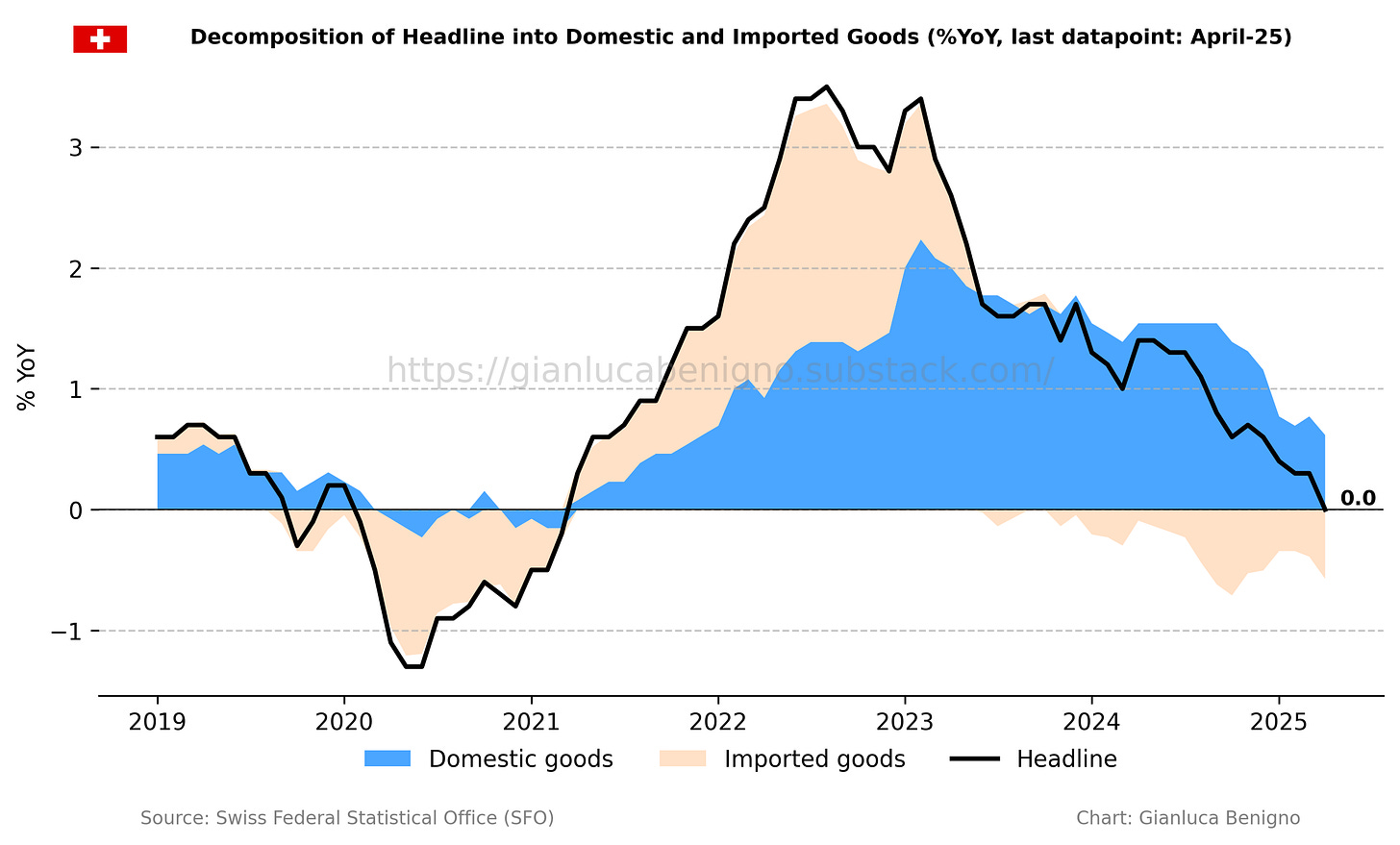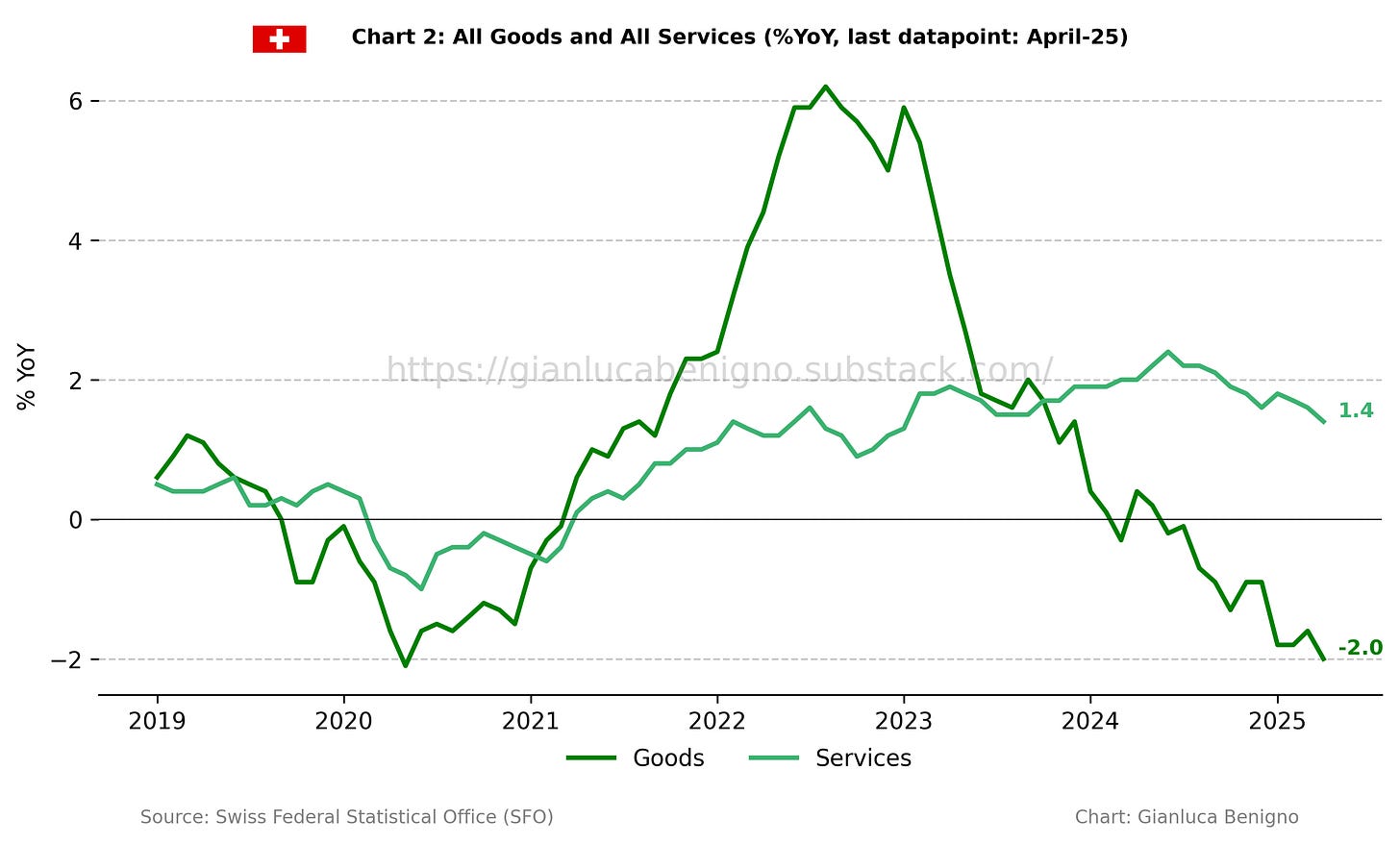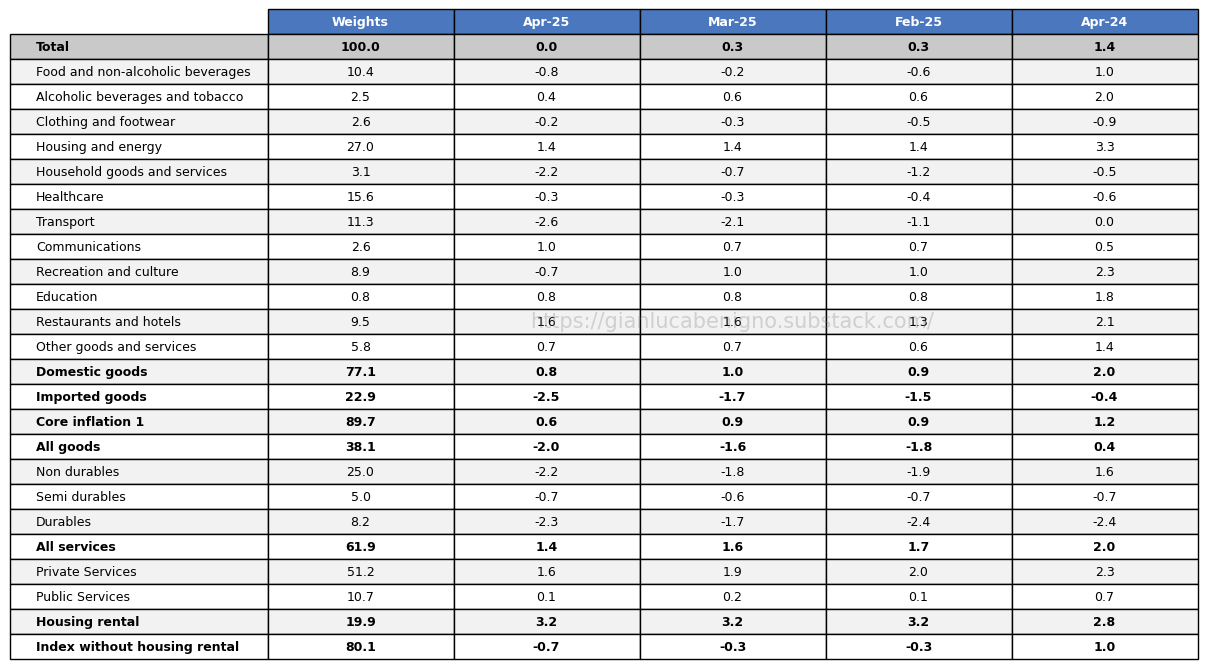Switzerland April-25 CPI Inflation Report
Further disinflationary pressure, combined with the appreciation of the Swiss franc, increases the pressure on the SNB to ease policy further.
Key takeaways:
In April 2025, the Swiss Consumer Price Index (CPI) stayed constant at 0% year-on-year (YoY), lower than March’s 0.3% YoY increase, and in line with the consensus forecast of 0% YoY. On a month-on-month (MoM) basis, April’s CPI was also 0% MoM, in line with the consensus forecasts of 0% MoM, and March’s 0% MoM reading.
Core CPI increased by 0.6% YoY in April, versus 0.9% YoY in March. On a month-on-month basis (MoM), core CPI increased by 0.1% MoM – the same as March’s 0.1% MoM increase.
As for virtually all previous releases, the services sector remains the primary driver of rising prices, experiencing a 1.4% YoY increase in April, down from March’s 1.6% YoY figure. In contrast, the goods sector declined by 2.0% YoY in April, lower than March’s 1.6% YoY decrease.
Housing rentals have trended upward since November 2023. Since this data is adjusted quarterly, the April release is the same as March’s, with an increase of 3.2% YoY—slightly lower than the 3.4% YoY increase recorded from November 2024 to January 2025.
These results are consistent with a common dichotomy faced by Central Banks in (major) advanced economies: goods prices are in a deflationary territory while service price inflation is slowly adjusting.
A parallel dichotomy arises in Switzerland by examining import and domestic prices, with import prices declining by a staggering 2.5% YoY in April (compared to March’s -1.7% YoY) and domestic prices rising by 0.8% YoY (versus 1.0% YoY in March and 0.9% in February).
Excluding housing rentals, CPI inflation declined by 0.7% YoY in April – far below February’s and March’s readings (-0.3% YoY).
From the SNB's perspective, the current release and the March release confirm the disinflationary outlook that has led to the further downward revision of the conditional inflation path outlined in its latest monetary policy assessment. While one more report is due before the next policy meeting, the continued strength of the Swiss franc makes it likely that the SNB will consider a further 25 basis point rate cut.
Related Posts
Switzerland March 25 CPI inflation report (previous release)
Switzerland February 25 CPI inflation report (previous release)
Switzerland January 25-CPI Inflation Report (previous release)
Switzerland December 24 -CPI Inflation Report (previous release)
Switzerland November 24-CPI Inflation Report (previous release)
The SNB’s Forward Looking Compromise (analysis of SNB’s September policy decision)
The SNB’s Challenging Rebalancing Act (analysis of SNB policy and Catch-22 effect for the SNB)
The SNB sets the time (analysis of SNB policy and Catch-22 effect for the SNB)
Review of the Inflation Release
Consumer prices rose by 0% year-on-year (YoY) in April 2025, versus March’s increase of 0.3% YoY, and in line with the consensus forecast of 0% YoY. On a month-on-month (MoM) basis, consumer prices similarly increased by 0% MoM, just as in March (0% MoM).
Core CPI, which excludes fresh and seasonal products as well as energy and fuels, increased by 0.6% year-on-year (YoY) in April (Chart 1), down from March’s 0.9% YoY figure. On a month-on-month basis, Core CPI increased by 0.1% MoM in April, just as in March (0.1% MoM increase).
Similarly to trends seen in other advanced countries, the services sector, rather than the goods sector, is the main driver of rising prices (Chart 2). In April, services increased by 1.4% YoY, down from the 1.6% YoY figure recorded in March. Meanwhile, the goods sector experienced a significant decline of 2.0% YoY, below March’s 1.6% YoY decline, showing persistence in good prices deflation.
A closer look at the disaggregated data (Tables 1 and 2) confirms that, as in other advanced economies, housing rentals remain the primary driver of inflation (see Chart 3). In Switzerland, this component of the Consumer Price Index (CPI) is updated quarterly and was unchanged in April from February and March, holding steady at 3.2% year-over-year, down from 3.4% in the previous quarter. As discussed earlier, movements in housing rents are closely tied to the policy rate. Given the SNB’s rate cuts over the past year, the moderation in rental inflation from its August–October peak is consistent with expectations. Still, housing rentals continue to exert significant upward pressure on headline inflation. Stripping out this component, the CPI fell by 0.7% YoY in April, down from February’s and January’s 0.3% YoY decline.
Another important classification from Switzerland's perspective is the distinction between domestic and imported inflation (see Chart 4). In April, domestic inflation rose by 0.8% year-on-year, slightly lower than the 1.0% YoY recorded in March. On a monthly basis, domestic inflation decreased by 0.1% MoM, in line with March’s reading. In contrast, imported inflation decreased by a staggering 2.5% YoY in April, far below March’s 1.7% YoY drop. On a monthly basis, imported inflation increased by 0.3% MoM in April, down from March’s 0.5% MoM increase.
The Swiss Federal Statistical Office also makes available a measure of the Harmonized Price Index of Consumer Prices (The Harmonized Index of Consumer Prices (HICP) is an indicator that the member states of the EU and EFTA calculate based on a harmonized method and allows for international inflation comparisons). In April, the HICP increased by 0.3% on a year-on-year basis, slightly higher than March’s 0.1% YoY reading.
Summary
The latest inflation report reinforces the disinflationary narrative. Goods prices continue to fall, and imported inflation remains subdued. Domestic inflation has consolidated around 1.0% for four consecutive months, and the higher monthly readings of the CPI at the core and domestic inflation levels are explained by the persistence in the housing rental component.
Since our last report in March, the U.S. has suspended its planned 32% tariff hike on Swiss imports, easing immediate trade tensions. However, the temporary nature of the suspension—and the broader geopolitical climate—adds a layer of uncertainty to the economic outlook. From an inflation standpoint, the appreciation of the Swiss franc, combined with potential further moderation in domestic inflation, particularly from declining housing costs, could prompt the SNB to ease policy further, potentially reaching a zero interest rate at its June meeting.
Table 1: CPI by components (% YoY)
Source: Swiss Federal Statistical Office (FSO).
Table 2: CPI by components (% MoM)
Source: Swiss Federal Statistical Office (FSO).











